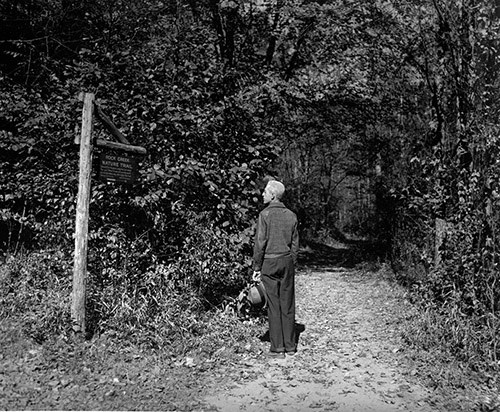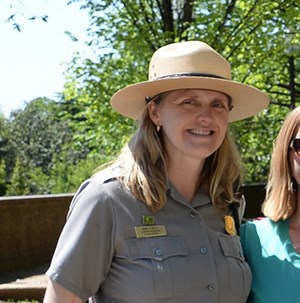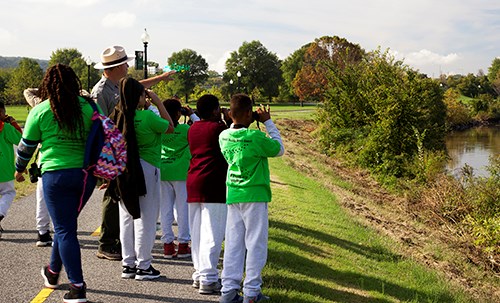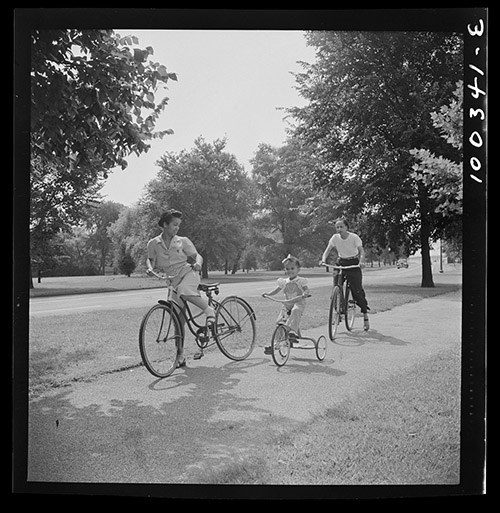The enjoyment of scenery employs the mind without fatigue and yet exercises it, tranquilizes it and yet enlivens it; and thus, through the influence of the mind over the body, gives the effect of refreshing rest & reinvigoration to the whole system. Frederick Law Olmsted, Yosemite and the Mariposa Grove: A Preliminary Report, 1865
Article
Cultural Landscapes and Community Well-Being: An Interview with ParkRx's Anne O'Neill

NPS Photo
Today, modern public health research shows that spending time in green spaces improves our mental, physical, and social well-being, by reducing stress and anxiety and helping control chronic diseases like diabetes and high blood pressure.
We don’t have to travel to Yosemite to enjoy these benefits. The expansion of the National Park System to include urban and historic sites in the 1930s and 1940s created many parks within easy reach of communities in and around Washington, DC.

NPS Photo
In a recent interview with the Park Cultural Landscape Program, Anne shared what she has learned about her work with the National ParkRx Initiative over the last five years, what it means for urban cultural landscapes, and how parks and public health belong together.
Check out the full conversation below.
What is ParkRx?
Anne: ParkRx is an initiative of agencies like the National Park Service collaborating with health providers to use public lands for the improvement of public and individual health. The goal of ParkRx is to create future stewards for our national public lands and to strengthen the relevance of national parks to their surrounding communities. We can do this by making it easy for doctors to prescribe visits and activities in parks.
Here’s how it works in Washington, DC:
If a doctor believes that time outdoors could help a patient with a physical or mental health condition, the doctor can enter the patient’s zip code into the ParkRx America website (formerly DCParkRx.org), which is linked to the patient’s Electronic Health Record, see the parks within a ¼-½ mile radius, ask the patient what activities they enjoy, and write a prescription to a park close to their home where they can follow their interests. Our DC Park work includes all city parks and national parks, gardens, and even some historic cemeteries where people may walk or bike.
What is your role in coordinating ParkRx in DC, and how do you fit in nationwide?
Anne: In the big picture, my job is to help make parks more relevant to all people, recognizing the trusted relationships health providers have in their communities and how they can help connect people to the parks. I work with partner organizations like ParkRx America, the DC Department of Health, our medical advisor, Dr. Robert Zarr, and other stakeholders inside and outside of the National Park Service to map the parks, energize our parks and partners, and create resources that can be used around the country like the ParkRx Day toolkit.
ParkRx programs have launched in San Francisco, Washington, DC, New Mexico, and many other states.The National Park Service’s Rivers, Trails, Conservation Assistance Program (RTCA) works with non-profit organizations such as Park Rx America (formerly DC ParkRx), the Institute at the Golden Gate, and the National Recreation and Park Association, as well as local and state park agencies and health departments.
Why are cultural landscapes important for ParkRx?
Anne: The National Park Service manages around 80% of the green space in Washington, DC, and protects green spaces in a region where development pressures are intense. Some of the key neighborhood parks for dense neighborhoods in DC are cultural landscapes. Anacostia Park is one of the primary recreational landscapes for residents of southeast DC. People go there for active team sports, roller skating, and bike riding, as well as more leisurely activities like strolling along the river trail, picnicking and viewing the wildlife.
Meridian Hill Park in northwest DC is also an incredibly popular designed landscape that is a national park and a National Historic Landmark. For many residents, this is the only green space they have access to. We held the first National ParkRx Day 2016 there, which took place on the the last day of National Park Week in April with Zumba, gardening, walks with dogs on their leashes, bike rides which began at the park, U.S. Park Police on horses, and a visit from the past U.S. Surgeon General.
Can landscape design and maintenance impact people’s health?
Anne: We have seen that the way we maintain these landscapes and balance use with preservation can make a big difference in how accessible they are. For instance, improving connections to neighborhoods at park entrances and adding wayfinding signs from Metro train and bus hubs can encourage people to walk to parks, maintaining the vegetation and structures within a park makes visitors feel more safe and welcomed, and connecting people to the diverse stories of a park can help people feel a sense of belonging. We all have our own pieces of the puzzle to contribute.
What are ParkRx’s biggest accomplishments in Washington, DC, so far?

NPS Photo
Anne: Because the National Park Service manages so much of the city’s green space, we have been able to work with other federal and state entities to map all the parks, trails, and other recreational features in the area. Washington, DC is also unique in the country at the moment because our park data is connected with the electronic health record.
Right now, doctors in Unity Health Care and National Children’s Medical Center, which together provide around 80% of healthcare for DC residents, are prescribing parks for people’s health. We are lucky to have Dr. Robert Zarr as DC’s ParkRx champion, because you need to have someone who really believes in this to be a voice within the health provider community. A pilot study he led in Washington, DC, found that after receiving their Park Rx, children were more likely to spend time outdoors and being physically active, and parents were more likely to recognize the value of physical activity outdoors for their families.
What does the future hold for Park Rx?
Anne: The next step is to help more doctors learn how to provide park prescriptions. We also want to reach the other 20% of health providers in DC, and expand beyond the city’s boundaries to include more parks in the Maryland and Virginia areas. Continued research is also important. If we can show how this low-cost approach can make a real difference in people’s health, we can help change the health care system in the US and national parks will be relevant to a new generation of stewards.
What would you like landscape and history enthusiasts to know?

Photo by Marjory Collins (Library of Congress)
Anne: With the current stressors in our country and world at this moment, we must be more aware that our green spaces are vital to heartbeat of local communities. When people do not have access to greenspace, communities suffer from higher violence, obesity, and other preventable, chronic health issues.
Looking back at Olmsted and the history of the national parks, we see that from the beginning, the creation and preservation of parks was for the well-being of people. It is important to understand the needs of the communities and balance preservation with new, dynamic uses that make parks relevant to the public today.
Last updated: October 15, 2021




